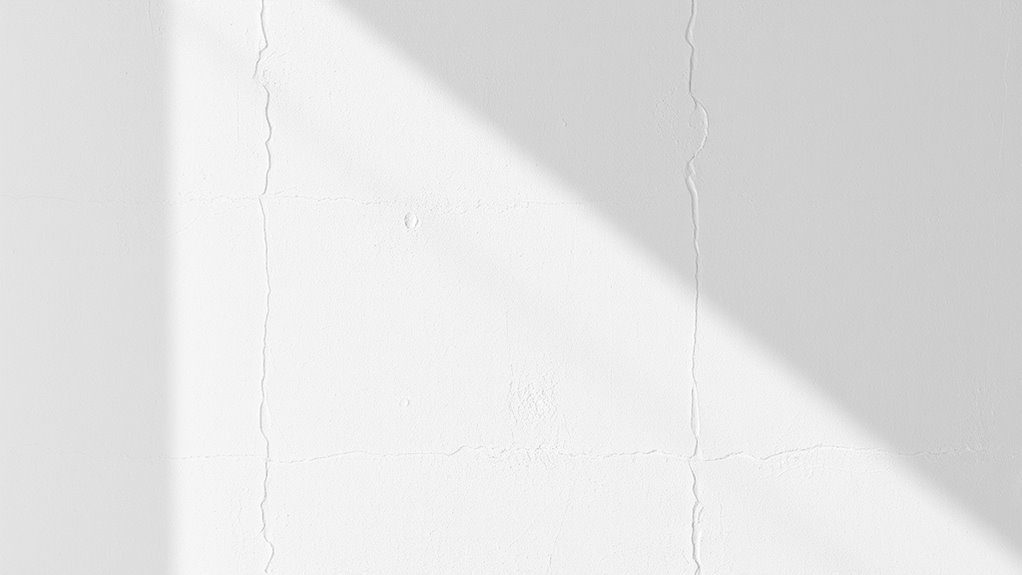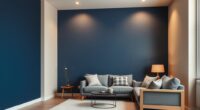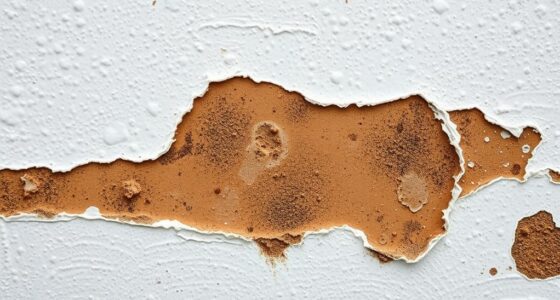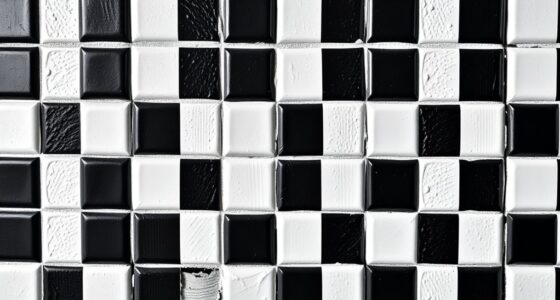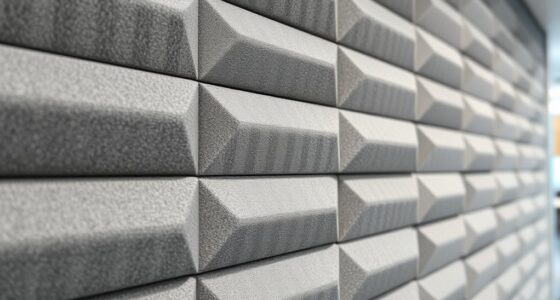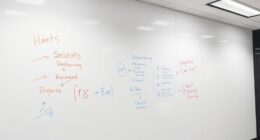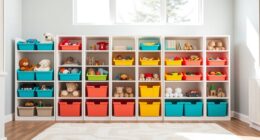A level 5 drywall finish guarantees a perfectly smooth, reflective surface ideal for high-quality painting or designs that need a flawless appearance. To achieve this, you apply multiple coats of joint compound, feathering and sanding each layer to blend seams and imperfections seamlessly. The process requires patience, proper tools, and careful sanding to create a mirror-like finish. If you want to master this professional look, continue exploring the detailed steps involved.
Key Takeaways
- A Level 5 finish provides a smooth, mirror-like surface ideal for high-gloss paint and reflective finishes.
- It involves applying multiple coats of joint compound, feathering edges, and thorough sanding for seamless blending.
- Proper tools and techniques, including fine-grit sanding and gentle strokes, are essential for a flawless result.
- Achieving a Level 5 finish enhances the aesthetic appeal and value of a space by creating an even, professional appearance.
- Factors like high-quality joint compounds and patient application are critical to minimize imperfections and reduce rework.
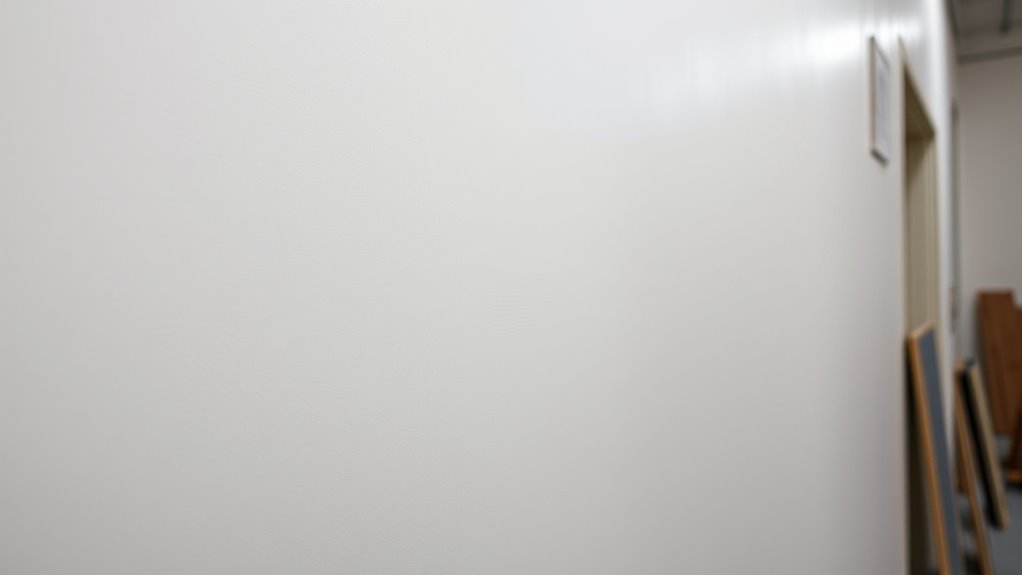
Have you ever wondered what makes a drywall surface look smooth and professional? The secret lies in the meticulous application of joint compound and the right sanding techniques. Achieving a flawless Level 5 finish requires patience and attention to detail, but the results are worth it. When working with joint compound, you want to ensure that each coat is applied smoothly, filling in any imperfections or seams. Using a putty knife or trowel, spread the compound evenly over joints, nails, and screw holes. After each coat, allow it to dry thoroughly before sanding. Sanding techniques play a vital role here; you need to use a fine-grit sanding sponge or paper, and gentle, even strokes to smooth out the surface without creating gouges or uneven spots. The goal is to blend the joint compound seamlessly into the drywall so that no ridges or lines remain.
A Level 5 finish demands multiple coats of joint compound—typically three or more—each applied with precision. Between coats, you should lightly sand the surface, removing any high spots or rough patches. Pay close attention to the edges and corners, as these areas are more prone to visible imperfections. When sanding, keep the dust to a minimum by using a vacuum or a damp cloth nearby, and wear a mask for your safety. The technique involves feathering the edges of each coat, gradually tapering the joint compound so it blends smoothly into the drywall surface. This process reduces the visibility of seams and creates an almost mirror-like finish. Additionally, understanding sanding techniques is essential for achieving a perfect surface, especially in high-gloss or reflective finishes.
It’s important to note that the quality of your joint compound also impacts the final look. A high-quality, setting-type compound can help achieve a smoother surface and reduce the number of coats needed. However, regardless of the product, mastery of sanding techniques is essential. Light, consistent pressure and the right tools make all the difference. Take your time during each step; rushing can lead to uneven patches that require more sanding or additional coats. The goal is to create a surface so smooth that light reflects evenly, making it ideal for high-gloss paints or reflective finishes. With patience, proper application of joint compound, and careful sanding, you’ll end up with a professional, Level 5 drywall finish that enhances your space’s overall look and feel.
Frequently Asked Questions
What Tools Are Best for Achieving a Level 5 Finish?
Think of your tools as a painter’s brush, essential for a perfect finish. To achieve a level 5 drywall finish, you need a high-quality taping knife and a fine sanding sponge or block. Use a finishing trowel for smooth joint compound application, then carefully sand with fine-grit sanding tools. These tools help you create a flawless surface, like a blank canvas, ready for painting.
How Long Does a Level 5 Drywall Finish Typically Last?
A level 5 drywall finish typically lasts 15 to 20 years with proper care. Its durability lifespan depends on factors like environmental conditions and maintenance. To guarantee longevity, you should regularly inspect for cracks or damage and address issues promptly. Proper cleaning and avoiding excessive moisture help preserve the smooth surface. If well-maintained, your level 5 finish can stay pristine for many years, minimizing repair needs over time.
Can DIYERS Achieve a Level 5 Drywall Finish?
You can attempt a level 5 drywall finish, but it’s a delicate art that requires patience and precision. Imagine the smooth, flawless look of high-gloss paint sheen; achieving that starts with choosing the right primer to create a perfect base. While DIYers can reach this level, it often demands experience and careful sanding, so consider whether your skills and tools match the challenge for a seamless, professional-looking result.
What Are the Cost Differences Between Level 4 and Level 5 Finishes?
The cost comparison between level 4 and level 5 drywall finishes shows that level 5 is markedly more expensive. You’ll face higher material expenses because achieving a flawless surface requires extra joint compound, primer, and meticulous sanding. Additionally, labor costs increase since applying a smooth, blemish-free finish takes more time and skill. Overall, expect to pay about 20-30% more for a level 5 finish compared to level 4.
How Does Humidity Affect the Drywall Finishing Process?
Oh, humidity loves to turn drywall finishing into a moisture mystery! When humidity spikes, you need humidity control to prevent your drywall from soaking up water like a sponge. It also extends drying time, making your project drag on longer than a bad joke. Keep the environment dry and well-ventilated, so your finish stays smooth and flawless, not swollen and splotchy. Don’t let humidity sabotage your perfect drywall job!
Conclusion
Achieving a level 5 drywall finish transforms your space into a smooth, flawless canvas, like a painter’s perfect blank slate. It’s the final brushstroke that elevates your project from good to breathtaking, whispering promises of perfection and pride. When you commit to this meticulous finish, you’re not just finishing drywall—you’re crafting a masterpiece that invites admiration and admiration. Embrace the process, and let your walls tell a story of craftsmanship and passion, shining like a beacon of excellence.
